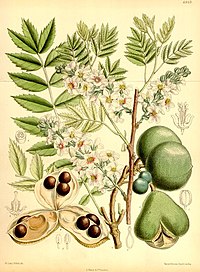
Photo from wikipedia
Xanthoceras sorbifolia Bunge is a folk medicine in China. Recently, the triterpenoids in its husks have attracted more and more attention for potential prevention against Alzheimer's disease. However, current studies… Click to show full abstract
Xanthoceras sorbifolia Bunge is a folk medicine in China. Recently, the triterpenoids in its husks have attracted more and more attention for potential prevention against Alzheimer's disease. However, current studies on its bioactive substances were still insufficient. To reveal more bioactive substances, an efficient and practical strategy based on high resolution mass spectra coupled with multiple data mining techniques was developed to characterize the barrigenol type triterpenoids in the husks and dosed rat plasma. A total of 50 barrigenol type triterpenoids were identified in the husks, and 6 of these were detected in the rat plasma, which were regarded as bioactive candidates. To find the real bioactive substances, the neuroprotective effect of the candidates was further tested by calculating the PC12 cell viability against amyloid-β-induced cytotoxicity. As a result, three out of the six candidates exhibited obvious neuroprotction against amyloid-β-induced cytotoxicity on PC12 cells, indicating their potential to be bioactive substances against Alzheimer's disease. This study will be a valuable reference of the bioactive substances in Xanthoceras sorbifolia Bunge husks against Alzheimer's disease and the provided strategy can also be applied to the exploration of the effective constituents in other medicines.
Journal Title: RSC Advances
Year Published: 2018
Link to full text (if available)
Share on Social Media: Sign Up to like & get
recommendations!